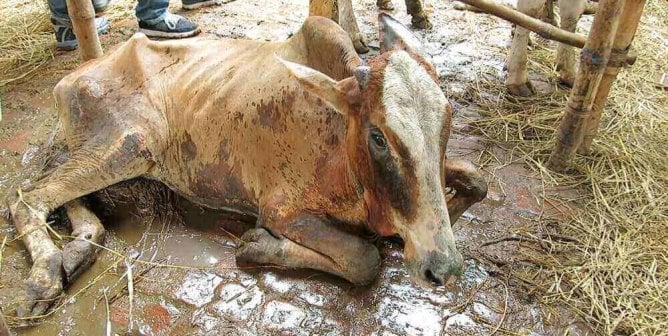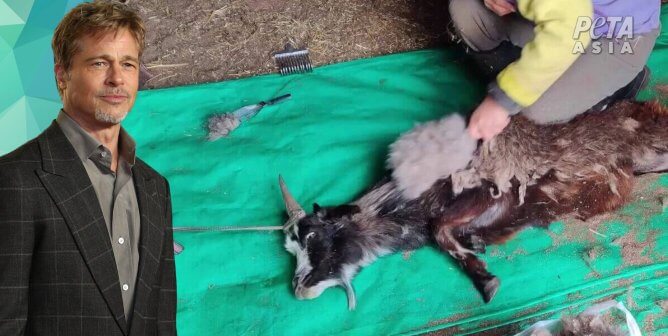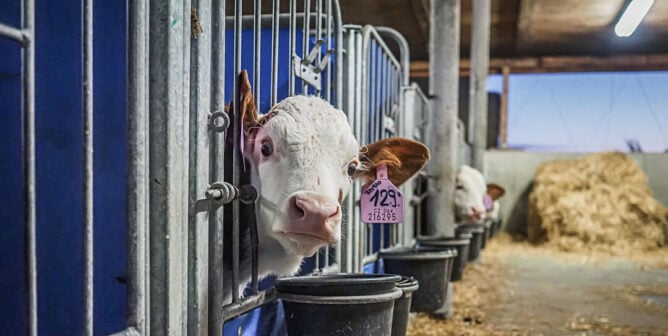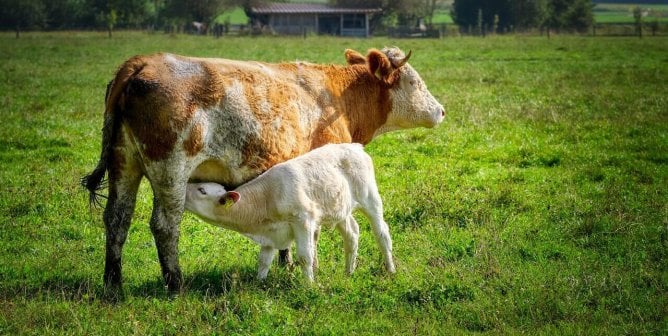Free-Range and Organic Meat, Eggs, and Dairy Products: Conning Consumers?
As people become more aware of the horrors of factory farming, companies are responding by labeling their products “all-natural,” “free-range,” “free-roaming,” or “organic.” But these labels are misleading. Most “free-range” animals are still mutilated and forced to endure long trips to slaughterhouses without any food or water. Moreover, they all have their lives violently cut short and are denied the opportunity to engage in anything that is natural and important to them.
‘Free-Range’
Companies want consumers to believe that products labeled “free-range” or “free-roaming” are derived from animals who spent their short lives outdoors, enjoying sunshine, fresh air, and the company of other animals. Labels—other than “organic”—on egg cartons are not subject to any government regulations, and the U.S. Department of Agriculture (USDA) does not regulate “free-range” or “free-roaming” claims for beef products.1
The USDA requires that “free-range” animals have access to outdoor areas, but there is no provision for how much time they must be allowed to spend outside or how much room they must be provided with to do so. USDA’s regulations only require the birds have “been allowed access to the outside.”2 Even if a farmer opened the door to a coop with thousands of birds inside and then closed it before any chickens went outside, he would still be able to use the “free-range” label.3
Because of genetic manipulation, even if an outdoor area is available, many chickens do not take advantage of the so-called “access.” One farm expert explains that chickens raised for meat in the U.S. are not bred for “mobility” but for “hogging down food” and adds that because they simply cannot walk, the birds rarely venture far from the feed trough.4 A study of approximately 800,000 chickens kept on free-range farms in the United Kingdom found that even though U.K. regulations require birds to have access to outdoor areas for at least eight hours a day, “the maximum number observed outside during daylight hours at any one time was less than 15% of the total flock.” The study stated that “chickens prefer ranging areas with trees [and] they avoid bright sun” and that “[a] wide open field is simply not a preferred habitat.” The researchers explained that domesticated chickens, much like their wild ancestors, need a habitat that provides shelter from wind, sun, and predators and that free-range operations should provide birds with more protection if they want to entice them to roam outside the barns.5
Regardless of what egg cartons may say, most hens raised for their eggs are subjected to cramped, filthy conditions until their egg production begins to wane—at about 2 years of age—and then they are slaughtered.6 A PETA investigation of “Nellie’s Free Range Hens” (which are “certified humane” and sold at stores like Harris Teeter, Walmart, and Whole Foods) documented that thousands of birds were crammed tightly together and that visitors found it difficult to avoid stepping on them. Even though the birds weren’t kept in cages, they still had only a little more than a square foot of space each. For more on this exposé, please visit PETA.org.
‘Organic’
Meat, poultry, eggs, and dairy products labeled “organic” have must come from animals who are “(m)anaged without antibiotics, added growth hormones, mammalian or avian byproducts,or other prohibited feed ingredients.”7 Farms, processors, and distributors must be inspected by the USDA before they are allowed to use the “organic” label. However, fewer than 4 percent of cows on dairy factory farms and fewer than 5 percent of chickens are raised in accordance with these standards.8,9 One cattle rancher complained, “Organic is a straightjacket [sic] with too many constraints.”10
Like the “free-range” label, the “organic” label does not guarantee that animals were treated any better than animals raised on conventional, prison-like farms. The Washington Post reported that large operations are able to sell their eggs as organic because the USDA has “interpreted the word ‘outdoors’ in such a way that farms that confine their hens to barns but add ‘porches’ are deemed eligible for the valuable ‘USDA Organic’ label. The porches are typically walled-in areas with a roof, hard floors and screening on one side.”11
Other Labels Regulated by the USDA
None of the following labels addresses animals’ living conditions or their welfare during transport or slaughter:
• “Certified”: Meat that has been stamped with this label has been “evaluated” by the USDA “for class, grade, or other quality characteristics.”12
• “Natural”: Use of this label is permitted if the product contains “no artificial ingredient or added color and is only minimally processed.”13
• “No Hormones”: This label applies only to beef and poultry. Because hormones are not supposed to be given to pigs or chickens, pork and poultry products cannot legally be tagged with this label without the disclaimer “Federal regulations prohibit the use of hormones.”14
• “No Antibiotics”: This label can be used on beef and poultry products, provided that the producer supplies “sufficient documentation … that the animals were raised without antibiotics.”15
Industry-Sponsored Programs
The National Pork Board offers U.S. pork producers Pork Quality Assurance Plus (PQA Plus), a voluntary program that “provides information to ensure producers can measure, track and continuously improve animal well-being.”16 PQA Plus is not enforced and does not offer farmers any incentive for implementing its standards.
United Egg Producers (UEP) uses a label that reads, “United Egg Producers Certified.”17 This program is also not regulated nor enforced, and investigations have proved that companies using this label do not treat chickens any differently than conventional farms do.
What You Can Do
Because there are so many different labels with inconsistent definitions and regulations, it’s difficult to determine which products are the most “humane.” Because none of the labels applies to transport or slaughter and none prohibits bodily mutilations such as debeaking, tail-docking, ear-notching, or dehorning, the worst cruelty continues to be completely unregulated.
From the “free-range” hen who smells fresh air for the first time on her way to the slaughterhouse to the “humanely raised” cow whose male calf is taken away from her and sold to veal farmers, all animals who are raised for food suffer. The only truly humane option is to choose vegan alternatives to meat, eggs, and dairy products. Call 1-888-VEG-FOOD or visit GoVeg.com to order a free vegetarian/vegan starter kit that contains information on faux meats, egg alternatives, and vegan dairy products.
References
1Food Safety and Inspection Service, “Meat and Poultry Labeling Terms,” U.S. Department of Agriculture, 10 Aug. 2015.
2Food Safety and Inspection Service.
3Charles Stuart Platkin, “Basics of Meat Labels, Part II,” The York Dispatch 6 Sep. 2006.
4Judith Blake, “Pasteured Poultry: Advocates Say Both Chickens and Consumers Benefit With Free Range,” Seattle Times 26 Aug. 2003.
5Marian Stamp Dawkins et al., “What Makes Free-Range Broiler Chickens Range? In Situ Measurement of Habitat Preference,” Animal Behaviour 66 (2003): 151-60.
6Ryan A. Meunier et al., “Commercial Egg Production and Processing,” Department of Curriculum and Instruction, Purdue University, 4 Apr. 2003.
7Agricultural Marketing Service, “Organic Livestock Requirements,” The National Organic Program, U.S. Department of Agriculture, Jul. 2013.
8Ag Marketing Resource Center, “Organic Dairy Profile,” U.S. Department of Agriculture, Nov. 2017.
9“About The U.S. Egg Industry,” American Egg Board, 1 May 2018.
10Doreen Muzzi, “Cattleman Wants to Bypass Middleman,” Delta Farm Press, 10 Oct. 2003.
11Peter Whorisky, “More Than A Million Hens, Filling Barns at Three Per Square Foot. And Yes, They’re USDA Organic,” The Washington Post,” 13 July 2017.
12Food Safety and Inspection Service.
13Food Safety and Inspection Service.
14Food Safety and Inspection Service.
15Food Safety and Inspection Service.
16National Pork Board, “Pork Quality Assurance® Plus,” Pork.org, 2018.
17“Animal Husbandry Guidelines for U.S.Egg-Laying Flocks,” United Egg Producers, 2017.








